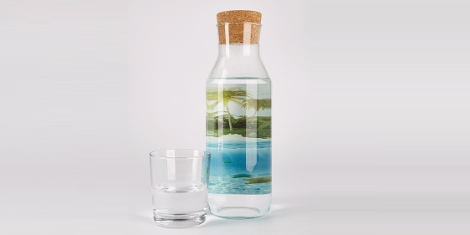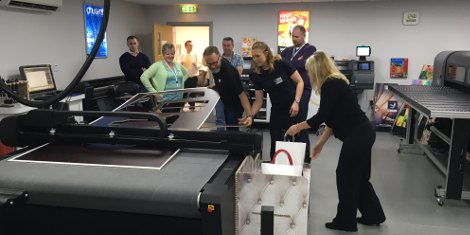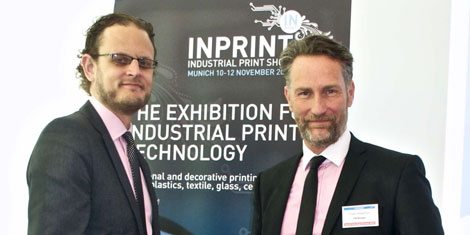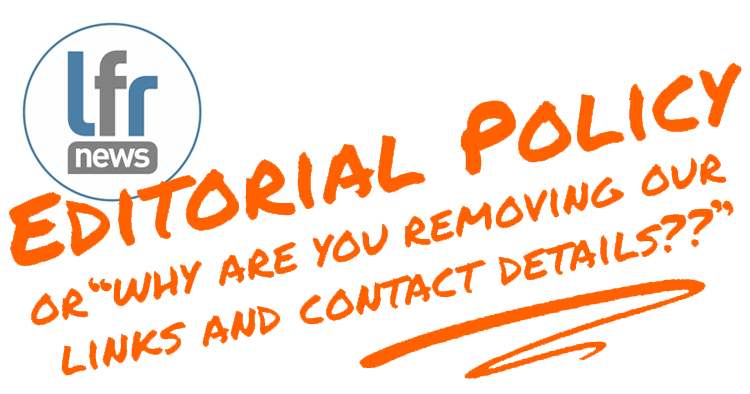During 2023 the Large Format Review website averaged over 29,000 unique monthly visitors - the majority of them sign and display print professionals - who visit our website a total of more than 179,000 times between them, reading 487,000 total pages of content as an average, each and every month.
Blog

In his latest blog, Mike Horsten, General Marketing Manager EMEA at Mimaki Europe B.V., discusses the value of printing glass:
The world of cosmetics is the place to show off, often with fancy printed bottles and glass containers whose value is higher than the contents inside.
Yes, the container has been more important to this industry than any other. With a good-looking bottle, you can sell more; with a good fragrance in an ugly bottle, the sales are likely to be low and unprofitable.
This presents a great opportunity for digital print. Today, the cosmetics industry is facing the challenge of what I call the “Personal Luxury feeling.” The ability to buy your own personalised cosmetics or perfume containers will be a big trend in the not-too-distant future. Just imagine a standard bottle with the print different for each customer! It is a new sales and marketing strategy that will change the cosmetics industry. It would drive profits up, since many consumers would pay extra for this service.
But there are some problems, of course, or perhaps it would already be a widespread practice. Glass printing is not easy; the print needs to be able to withstand alcohol and rubbing tests, the print needs to be human safe, and it needs to be very clear and sharp. The reason for the clarity and sharpness is the large amount of fine text that is needed on a cosmetics product, including the ingredients, shelf life and the barcode for the product; they all need to be sharp and straight. Printing on a flat surface is easy; but most bottles are round, so there needs to be a simple way to print on round objects. Some products are in big containers and some are in small round ones, like mascara or liquid foundation. So there are some hurdles to overcome. In addition, many of the caps for these products are made of plastic, which presents yet another challenge.
Traditionally, printing on glass was done via tampon/pad silkscreen printing. This process requires a new print for each colour, which is why you see so many cosmetics products with only one colour print, mostly white. Using more colours is difficult due to the fact that you need to line up the different colours and you would have to use halftone screens to get the job done. I’m not even speaking of the registration problems one would face between colours. On a round object, this would be a real nightmare. Then you need to know that the current generation of primer and/or inks that are used have been specially made for glass printing, specifically for good adhesion to the glass object. Another problem is that the glass is moved through the filling machines after it has been printed, so there is always a risk that the print will be scratched or damaged, making the container unsellable. To address this risk, most printers put a large amount of ink on the container to make sure it stays on. This can be seen on most cosmetics products on the shelf today.
With a digital printing system, we can eliminate most of these problems. First, we can print in 16.8 million colours in contone mode, giving us nice photographic quality. We can add a varnish layer for protection of the print, and we can make each bottle personal. We can print them on demand, so no big production runs would be needed, saving huge amounts in inventory costs and improving cash flow. For printing on flat surface bottles and containers, this is already being done today, used by many of the larger brands for their specials and personalised holiday gifts, using products like our UJF Series printers. We have printed cosmetics boxes and containers around the holiday times in places like department stores such as Harrods in London, and in many airports around the world. Live printing, just wait 10 minutes and your personal product is ready. But this has always been a promo print, a “now or never” type of deal, and it certainly is not a common practice today. Although it has been very successful, it does not solve the production problems for small batches that need to be printed around the world. Did you know that there are more than 50 standards for the labelling of cosmetics products in the world? The languages, the legislation and the fine print are different from jurisdiction to jurisdiction. Customising the packaging translates to unsustainable costs for high-street brands whose expensive perfumes and cosmetics might be produced in low volumes with diverse content.
We have been working on a solution for these problems together with the primary players using the new generation of UV-LED curing flatbed Mimaki printers. We have developed new inks and printable primers that can be used to print on glass. Although there are always some extra requirements needed for printing directly on glass, we have solutions like external primers that help minimise those challenges. The biggest challenge, though, was printing on round objects. This has never been easy, but with the addition of our optional Kebab solution, we are now able to print on round objects with a diameter ranging from 1 cm to 11 cm. This means you can print just about all types of bottles and containers with one printer. The examples are numerous and the applications endless. The funny thing is that you can even print customised content on the boxes containing your special product. Our UJF7151 Plus was made for an industrial market that demands high-speed production and quality all at the same time.
Working on the development of new and faster printers for the industrial glass print markets has brought some challenges to the marketplace, but we have a viable, affordable solution available today that will help to begin this exciting packaging transformation.
So next time you look at a cosmetics or perfume bottle, think about how it would look without print. Or better yet, visualise it customised especially for you with text or images of your choosing. As I said, “What’s a bottle without a title?”
Let’s Create Together
Mike Horsten, General Manager Marketing EMEA @ Mimaki Europe

Nottingham-based specialist distributor ArtSystems has enjoyed a buoyant 2015 and has plenty of irons in the fire for an even better 2016, says Ted Freer, Sales Divisional Manager.

We recently took some time out to ask the InPrint Co-Founders Marcus Timson and Frazer Chesterman three important questions to help understand more about the thinking behind their InPrint show. Nothing clever from us here - we've simply asked the questions we feel most people would themselves ask if Marcus and Frazer were stood in front of them.

1. Why is InPrint important to the Print Industry?
FC: I am going to be direct, because this is our ‘call to action’ for the Print industry. InPrint is the most important ‘Print’ event in 2015. If you are really serious about looking at the future of your print business, then you should take a few hours to take a look at this event. You can get a free activation code at the end of the article.
Why? Because our industry is changing and the technology you will see at InPrint is different. I’ll give you an example: if you attended one of this year’s traditional wide-format or label shows, you might have seen bigger, better, faster….. which is fine, but this is about persuading you to buy a new bigger, better, faster machine to compete in a crowded market.
What you see and experience at InPrint is something entirely different, something new, somewhere different to sell your print services. This 'somewhere’ is the market that all of the manufacturers and all of the researchers recognise to be where the new market is going.
Consider also the way that DRUPA have changed their approach for next year’s show - with emphasis on areas such as print innovation, inkjet, functional print and 3D print - to me it is clear that things are changing. We are not focusing on an established and mature segment that is not really growing at the pace that it previously has been. The growth in industrial print technology whether it is inkjet, 3D or the continued growth of industrial screen print is greater than any other.
With our previous experience and our knowledge and understanding of growing exhibitions in developing markets combined with our partnership with Mack Brooks (One of Europe’s most successful trade show organisers) we are well placed to deliver a fantastic second event in Munich.
MT: It is important for a number of reasons, but the biggest reason I think is the fact is that his show is at the pinnacle of what print technology is capable of. InPrint is not a mainstream show. It is a show dedicated to advanced printing technologies that are pushing the boundaries of what is possible within manufacturing so as a result it is about now and the future. It is a unique show for visitors wanting to solve complex production problems and unlock new potential. It is not really a box shifting type of show.
2. Why should a visitor decide to attend the show? What will they see and experience?
FC: I’ll give you three good reasons to visit the show:
Firstly, this event is the only exhibition that focuses 100% on the evolving technology that we all refer to as ‘Industrial Print’. And it is clear from the research by all the major research bodies – IT Strategies, Infotrends and Smithers PIRA - that this is the ‘growing‘ part of the print market and it is set to continue this growth trajectory for the next few years. So if you are a printer who is considering where your business will come from in the future, you should at least be looking at this sector.
Secondly, we are fortunate enough to have over 80 speakers from the ‘Industrial Print’ sector delivering high value content in our InPrint Conference programme. This content is available without any additional cost to all visitors and is within two Theatres on the show floor, so easily accessible and representing the most comprehensive educational programme available in this format for 2015. I think attending for that alone is a no-brainer. If you are thinking ‘where can I go to understand more about the new developments in print', then Messe Munich 10-12th November is the place. You also get the extra value of your ticket giving you direct access to both InPrint and Productronica.
Thirdly, as a leading exhibition with one focus, we combine respected, traditional Industrial print methods such as screen print with the truly new and innovative technologies such as inkjet and additive manufacturing for the industrial segment.
What was really interesting last year with the first InPrint show was the number of visitors from the manufacturing industry. This is unlike any other print show in Europe. There is no denying that this show bridges the gap between the print sector and the end user Industry – with large numbers of visitors registering from the automotive, aeronautic, electronics, white good manufacture – and the developed/integrator market – helping us to develop an event that allows the print industry to rub shoulders with the a different part of the supply chain. But undoubtedly it's the sector that is really becoming excited by print technologies.
MT: They will see plenty of new products and ideas, meet experts who are able to solve complex problems and learn from over 60 conference sessions. It is not a show for posters, paper or anything you would expect to find at a regular print related trade show. If however a visitor is keen to develop new technologies that fit within a very specific manufacturing sector or marketplace, then this show is the perfect event that will provide unique access not only to advanced and sophisticated technologies for screen, digital, inkjet, speciality and 3D printing, but the expertise and people who know how to solve these problems.
3. What is your Vision for the show / and for the industrial print in the future?
MT: The show mantra is to ‘Lead the Future of Industrial Print’. So in this sense it is to continue to position the show to provide our growing industrial print community. Industrial printing is also unique in its growth. With 36% average growth across all sectors between 2012-2020 it outpaces any other print segment so if anyone is interested in joining this rapidly growing sector then InPrint is the show to attend.
FC: As the fastest growing Print technology event of 2015, we have a clear vision of growth. From the Hannover event in 2014 to the Munich event of 2015 we have seen a 50% increase in the number of exhibitors and we are have doubled the amount of conference content. No other event in the print industry has done this in 2015, so we are clear that there is an accelerated interest in the subject of industrial.
We believe there will be certain key trends which our show programme will match. For next November 2016, we will be in Milan, Italy and the emphasis will be on the decorative sector covering textile, glass, plastics, wood and ceramics for both interiors and exteriors as well as fashion. Whilst in Germany we will continue to see the functional and packaging sectors grow. We will also observe trends further afield and look to reflect significant industrial print developments with events to match the interest and demand on this exciting and developing sector.
- If you are reading this and would like a Free ticket to attend InPrint 2015 (November 10-12th Messe Munich) then please click here to activate your free code.

There’s a psychological condition called ‘Imposter Syndrome’. It was first recognised back in the 1970s. At that time it was believed that only women seemed to suffer from it, but it isn’t sexist - it can affect anyone. Famous high achievers like Albert Einstein, Neil Gaimen, Terry Pratchett and Jim Carrey have all bowed under the condition, and if you are intelligent and a perfectionist the chances are you have too, at some point in your career.

In what has proved to be a politically turbulent month, Chancellor George Osborne has announced that he will present the 2015 Autumn Statement in conjunction with the Spending Review, on Wednesday 25 November. All eyes will be on the Chancellor as he presents his Statement opposite the newly elected Labour leader Jeremy Corbyn and shadow Chancellor John McDonnell.





